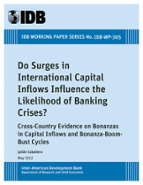Do Surges in International Capital Inflows Influence the Likelihood of Banking Crises?: Cross-Country Evidence on Bonanzas in Capital Inflows and Bonanza-Boom-Bust Cycles
Date
May 2012
This paper asks whether bonanzas (surges) in net capital inflows increase the probability of banking crises and whether this is necessarily through a lending boom mechanism. A fixed effects regression analysis indicates that a baseline bonanza, identified as a surge of one standard deviation from trend, increases the odds of a banking crisis by three times, even in the absence of a lending boom. Thus, a bonanza raises the likelihood of a crisis from an unconditional probability of 4.4 percent to 12 percent. Larger windfalls of capital (two-s.d. bonanzas) increase the odds of a crisis by eight times. The joint occurrence of a bonanza and a lending boom raises these odds even more. Decomposing flows into FDI, portfolio-equity and debt indicates that bonanzas in all flows increase the probability of crises when the windfall takes place jointly with a lending boom. Thus, windfalls in all types of flows exacerbate the deleterious effects of credit. However, surges in portfolio-equity flows seem to have an independent effect, even in the absence of a lending boom. Furthermore, emerging economies exhibit greater odds of crises after a windfall of capital.



